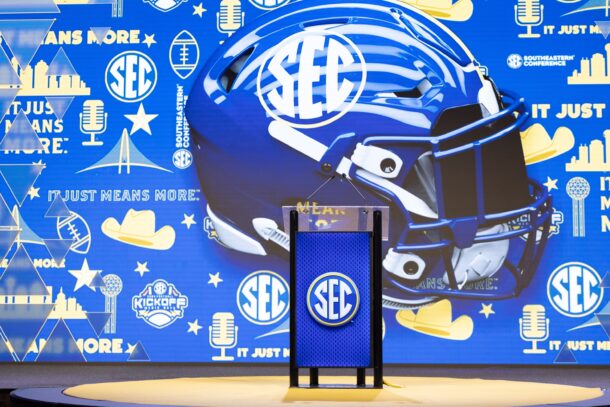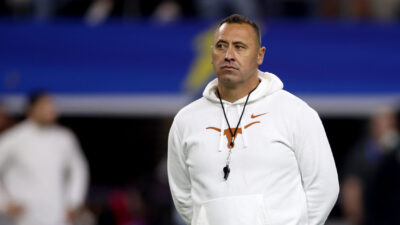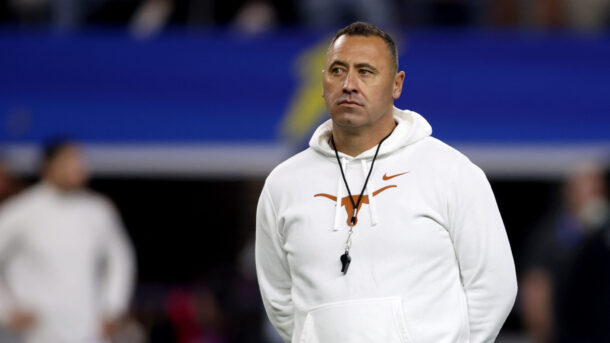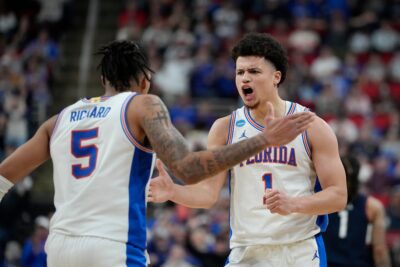Ad Disclosure
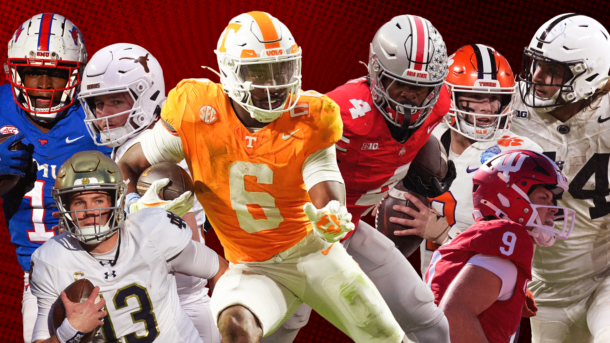
The Ultimate Playoff Primer: At long last, the real tournament is here. Bring on the madness
By Matt Hinton
Published:
Everything — and we mean everything— you really need to know about this weekend’s first-round matchups in the inaugural 12-team College Football Playoff. All odds are via DraftKings Sportsbook.
— — —
From the dawn of time, man has dreamed of a College Football Playoff.
Think about how long it has taken to arrive at this moment. If you’ve been around a while, you can probably remember when the very concept of settling the national championship on the field seemed like a faraway fantasy akin to science fiction. We would get flying cars and a cure for baldness before we got a real, honest-to-God bracket in big-time college football.
Consider the various stages of evolution over the course of more than 30 years that brought the sport kicking and screaming to its final destiny. Out of the primordial ooze of the old pell-mell bowl system, there arose the Bowl Coalition (1992-94), which begat the Bowl Alliance (1995-97), which begat the dreaded Bowl Championship Series (1998-2013). Cursed as it was, the BCS was the first effort that successfully merged all competing interests under the same umbrella and subsequently convinced most of the world that it did indeed represent The National Championship in major college football. If that’s all it succeeded in doing, it was still the crucial link from the 20th Century to the 21st, which finally arrived with the first iteration of the 4-team Playoff in 2014.
A decade later, here we are. No polls. No “computer polls.” Not 2 teams. Not 4. Twelve, in all their glory.
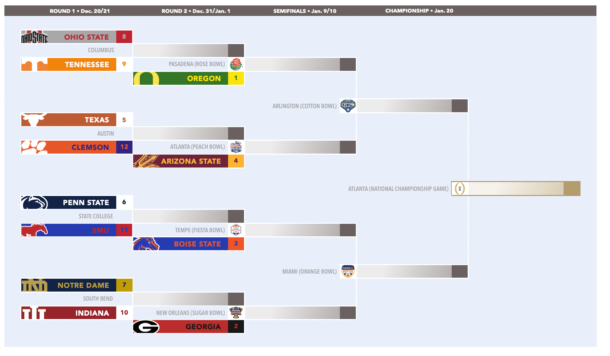
So much of the oxygen in college football is consumed these days by complaints about what’s wrong with it, much of which boils down to “changing too fast to keep up.” But the expanded Playoff is the one big idea (possibly the only one) that the sport’s embattled leadership has, at long last, gotten right. It is decades overdue. This, right here, is what it should have been all along.
Beyond the structure of the thing — big thumbs up to auto bids for conference champs and on-campus dates in the first round — the field itself in Year 1 is as compelling as anyone could have asked for. In the absence of an obvious, prohibitive Playoff favorite, there are at least 6 teams that could plausibly win it all without pulling a major upset. That includes Georgia, Texas and Tennessee. The other half of the field includes the likes of Arizona State, Boise State, Indiana and SMU, outfits that have rarely enjoyed a sniff of national relevance and even in their best years could have hardly dreamed of getting a legitimate title shot under any previous arrangement. Seriously, Indiana! The Hoosiers are here in the wake of the best regular season in school history, and from this point on it doesn’t matter one iota what anybody thinks of their schedule. Boise State, whose fans can still cite the exact circumstances of their many BCS snubs, has a bye, and didn’t have to go undefeated to get it.
Is it too good to last? We’ll see. Cynicism is easy: Before the first game has even kicked off, there are already murmurs about tweaking the format, or expanding it further (ugh) to ensure that the 4th- through 6th-best teams in the SEC get the seat at the table the committee denied them this year in favor of SMU. (A no-brainer for anyone not financially or emotionally invested in SEC superiority.) The word “broken” was in circulation immediately following the announcement of the field, for inscrutable reasons that seemed to stem more from a professional reflex for complaining than an attempt to describe anything real. The process is not broken; it hasn’t even had time to be. But that obviously doesn’t mean that certain brokers like SEC commissioner Greg Sankey aren’t determined to fix it in a way that leaves them with a larger slice of the pie.
But all of that is for another day. Right now, we’ve got it: The bona fide bracket this big, unruly sport deserves, with every team that deserves to be in it and none that don’t. We e got access for the underdogs, warm-weather teams consigned to the cold, and, at the end of a grueling month, an undisputed champion. The system works. These are the good times. Enjoy them while you can.
Let the games begin already.
Tennessee at Ohio State (-7.5)
Under normal circumstances, alluding to the hot seat in the context of a coach whose team is a serious contender to win the national championship would feel absurd. But nothing about Ryan Day‘s circumstances at Ohio State are normal. Ohio State coaches are hired to do two things — beat Michigan and win championships — neither of which’s Day’s teams have accomplished in far too long. The Buckeyes haven’t beaten the Wolverines since 2019, Day’s first year in the big chair, and haven’t won a Big Ten title or Playoff game since 2020, in an abbreviated season amid the COVID pandemic. At this point, even acknowledging his impeccable regular-season record against everyone except Michigan reads to OSU fans less like a defense of their coach than an insult to their pride.
As wounded as they were by the 3 straight losses to the Wolverines with the Big Ten crown and CFP implications at stake from 2021-23, this year’s 13-10 flop in Columbus was the anvil that broke the camel’s back. Ohio State was a 19.5-point favorite in that game, at home, over a thoroughly mediocre Michigan outfit in the depths of rebuilding mode. Instead, the Buckeyes’ $20 million roster was embarrassed on its own field by a rival starting a walk-on quarterback who averaged 3.9 yards per attempt with 2 interceptions in victory. Day, who described the rivalry in a pregame interview as “a war,” was caught by cameras during the postgame melee that ensued after Michigan attempted to plant a flag at midfield looking listless and powerless to intervene, reduced to asking a passerby “what happened?”
Every season at Ohio State is a championship-or-bust season, to one extent or another. This year, though, the sentiment feels quite literal: Regardless of whether Day is explicitly coaching for his job, for a large segment of the Buckeyes’ base, anything less than a national title (or at least a deep Playoff run) will go down as another irrefutable mark against his dismal track record in the games that really matter. And whatever his boss says, a first-round exit could very well spell the end.
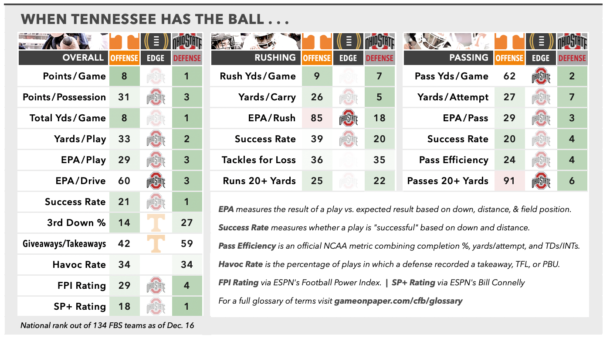
The QB: Before the season, Nico Iamaleava‘s size, mobility, and 5-star pedigree inspired visions of a dark-horse Heisman campaign. Instead, his role turned out to be more akin to a game manager. Still, within the context of a team that has relied more heavily on the ground game and defense than on his arm, Iamaleava continues to give off the vibes of a simmering talent capable of firing up the bandwagon on any given Saturday.
For one thing, even when he’s struggled to move the sticks, he hasn’t tended to make things worse: He posted the SEC’s 2nd-best interception rate (1.7%), serving up 5 INTs in 303 attempts, and wasn’t picked in either of Tennessee’s defeats. He also closed on a high note, pulling out of a midseason slump in time to deliver a mostly satisfying November. When he looks good, his potential is undeniable. His last time out, he threw 4 touchdown passes in a Playoff-clinching, 36-23 win at Vanderbilt, arguably his best outing of the year. In those tantalizing moments when it all comes together, Iamaleava looks like the complete package and Tennessee looks like a legitimate contender to win it all.
Not for nothing, the Vols’ 2 losses against Arkansas and Georgia were the 2 games in which he spent the most time under duress: The Dawgs and Hogs combined for 30 QB pressures (per PFF) and 9 sacks against a fully intact Tennessee o-line. The weakest links on that front have been the tackles, Lance Heard, John Campbell Jr. and Dayne Davis — Campbell and Davis share reps on the right side — who have all earned the wrong kind of attention at various points this season. They’ll be in the crosshairs Saturday opposite the Buckeyes’ long-tenured edge-rushing tandem, seniors JT Tuimoloau and Jack Sawyer, whose decorated careers to date have yielded a combined 225 pressures, 36 sacks and 6 forced fumbles. Neither Tuimoloau nor Sawyer has emerged as the unstoppable, All-American force Ohio State fans envisioned that they ultimately would; together, they’re still as formidable and well-rounded a pair of bookends as you’ll find on campus. Both are solid Day 2 types in next year’s draft who could plausibly play their way into Day 1 with a postseason surge.
The RB: Tennessee RB Dylan Sampson didn’t have much of a preseason profile and has flown below the radar nationally, like pretty every running back in America not named Ashton Jeanty. He’s not a home-run hitter or a viral sensation. Within the conference, though, his value was obvious, resulting in his coronation as the first running back to win SEC Offensive Player of the Year since Auburn’s Kerryon Johnson in 2017. In the regular season, Sampson accounted for 100+ scrimmage yards in 11 of 12 games, setting single-season school records for total yards (1,626) and rushing touchdowns (22) in the process. Against Power 5 opponents, specifically, that comes out to nearly 35% of the team’s total output on more than 25 touches per game — easily the highest individual share in the SEC, and among the highest in the country. Among Playoff teams, only Jeanty and Arizona State’s Cam Skattebo carried a heavier load.
Sustaining that pace in Columbus will be a feat. Man for man, Ohio State’s veteran front seven is as imposing as any in the country, and statistically Buckeyes are the best run defense Tennessee has faced by a mile. Then again, they’ve hardly been invulnerable, allowing individual 100-yard rushers in both of their losses against Oregon (Jordan James) and Michigan (Kalel Mullings) despite limiting to them to long gains of 25 and 27 yards, respectively. Sampson is imminently capable of adding his name to that list, and in similarly grind-it-out fashion. But only as long as the scoreboard allows the Vols to remain patient.
The WRs: As a group, Tennessee’s wideouts were relatively underwhelming. For big-play juice, though, they don’t make ’em much juicier than senior Dont’e Thornton Jr., a 6-5, 214-pound specimen who led the nation in yards per catch (25.9) and gains of 50+ yards (6) on just 25 receptions. As the resident deep threat, Thornton accounted for 7 of Iamaleava’s 15 completions of 20+ air yards, including long-range touchdowns against Oklahoma (66 yards), Mississippi State (73) and Vanderbilt (86). The flip side was a tendency to disappear for entire games; among other forgettable outings, he had just 1 catch for 11 yards against Florida and was shut out against Georgia. Still, his field-stretching presence alone should be enough to keep Ohio State’s secondary on alert against getting too single-minded about loading the box to stop Sampson.
For their part, the Buckeyes haven’t been especially vulnerable to giving up big plays — by ground or air — a testament in part to the elite safety combo of Caleb Downs (a consensus All-American) and Latham Ransom on the back end. Again, though, the exceptions were red-flag events. One corner, senior mainstay Denzel Burke, was memorably cooked in the loss at Oregon, allowing 7 catches on 7 targets for 162 yards on the worst night of his campus career; the Ducks connected on a pair of big gains at Burke’s expense on double moves, covering 69 yards and 48 yards, respectively, the latter for a touchdown. The other corner, junior Davison Igbinosun, has been a magnet for pass-interference penalties, drawing an FBS-worst 13 flags in coverage, per PFF. Patience notwithstanding, the Vols should not wait long to put that pair to the test.
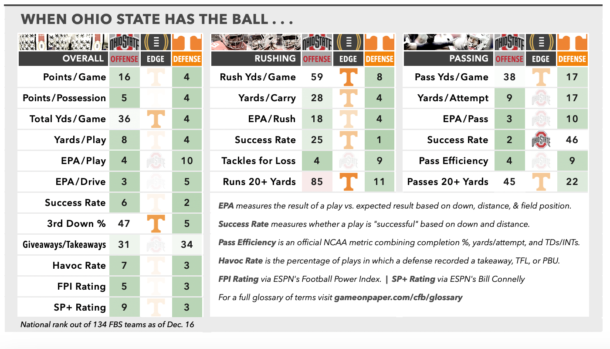
The QB: The knives are not out for Ohio State QB Will Howard to the same extent that they are for his head coach, but it’s hard to overstate how dramatically his stock plummeted in the loss to Michigan. Going into that game, Howard was hovering near enough to the Heisman orbit that it was possible to imagine a big afternoon against the Wolverines in front of a big national audience vaulting him onto the shortlist for a trip to New York. Instead, it went the other way: He melted down, turning in by far his worst performance of the season in the defining game to date of his one-and-done tenure as a Buckeye. As far as the locals are concerned, he’s just another guy who couldn’t win the one they wanted most.
Unlike the guy he replaced as QB1, however, Howard’s collapse against Michigan isn’t the end of the story. On paper, he still gives Ohio State as good a chance as any remaining quarterback in the field; for the season, he ranks No. 2 among Playoff starters in pass efficiency, 3rd in Total QBR and 3rd in total touchdowns, with 34. Prior to the finale, he’d thrown multiple TD passes in 9 consecutive games. His multimillion-dollar surrounding cast lived up to its bank account, headlined by freakish freshman wideout Jeremiah Smith, keeper of the flame at one of the sport’s most decorated positions; Smith was a first-team All-B1G pick in Year 1 and comes in just 70 yards short of 1,000 for the season, foreshadowing a full-blown Heisman campaign in Year 2.
On the other hand, no one has ever mistaken Howard for a game-changing talent on the order of a Justin Fields or CJ Stroud, either. A 24-year-old, 5th-year senior who spent 4 years at Kansas State, he has always projected as more of a veteran overachiever than a next-level prospect — if he comes off the board next spring it will almost certainly be in the later rounds — and his limitations have never been more glaring than they were against the Wolverines, who held Howard to 5.3 yards per attempt and picked him off twice with their best pro prospect, cornerback Will Johnson, in street clothes. He was already toiling under the perception that he benefits much more from the surrounding cast than they do from him. If a run is in the cards, the Buckeyes need him well-protected and in his comfort zone.
The OL: That begins up front, where much of the angst has been reserved for an injury-ravaged offensive line missing its 2 best players, left tackle Josh Simmons (a projected first-rounder) and center Seth McLaughlin (a consensus All-American in his first season at OSU after transferring from Alabama). In their absence, the reshuffled front has come in for mostly dismal marks from PFF, especially in the loss to Michigan. The new left tackle, Donovan Jackson, has struggled in pass protection since shifting outside from guard, giving up a dozen pressures and 2 sacks against Penn State, Indiana and Michigan alone. The new center, 2023 starter Carson Hinzman, reminded everyone against the Wolverines why Ohio State made replacing him an offseason priority, finishing with a 14.8 pass-blocking grade.
Their job will not be any easier against a disruptive Tennessee d-line, especially aspiring first-rounder James Pearce Jr. In a crowded year for productive SEC edge rushers, Pearce’s raw stats don’t exactly leap off the page: Officially, he tied for 11th in the conference in tackles for loss (11) and 8th in sacks, with 7.5. Both numbers are slightly down from last season. Look more closely, though, or simply turn on the film, and he was every bit as active as his elite rep suggests. Per PFF, Pearce ranked among the Power 5 leaders in total QB pressures (52) and win percentage, beating opposing blockers on 23% of his pass-rushing snaps. Per opposing coaches, he was still good enough to beat out a long list of worthy candidates for a first-team All-SEC nod. And he was at his best in the Vols’ 24-17 win over Alabama in Week 8, generating a career-high 10 pressures and 2 sacks in a money-making performance against the Tide. If the Vols stand a chance of advancing out of the OSU/Oregon corner of the bracket, that’s the kind of difference they need their most NFL-ready player to make.
The RBs: The surest-fire way to keep Howard clean, as always, is to keep him out of obvious passing downs. Ideally, the Buckeyes would love to be able to line up and pound the rock. Day has often bristled at the notion that his pass-oriented offenses are “soft,” and most of his offseason moves hinted at beefing up the ground game: He brought on a dual-threat quarterback (Howard), a spread-to-run innovator to take over a play-calling (offensive coordinator Chip Kelly), and a proven workhorse (Ole Miss transfer Quinshon Judkins) to ease the wear and tear on injury-prone RB TreVeyon Henderson. Before his injury, McLaughlin represented a clear upgrade over the weakest link on last year’s offensive line, Hinzman.
All told, though, the results have been mixed. Rushing production is up over a lackluster effort in ’23 but remains inconsistent week-to-week; Judkins and Henderson played in every game but essentially split the load of 1 full-time back, combining for 1,013 yards and 5 touchdowns in conference play. Howard’s impact as a runner has been largely relegated to the red zone. And, in a recurring theme of Day’s tenure, Ohio State was physically whipped in the trenches by Michigan. Tennessee’s d-line doesn’t boast anything like the individual interior beef that the Wolverines have in Mason Graham and Kenneth Grant — few teams do — but does rotate 5 DTs listed at 300+ pounds apiece. Grinding out a living between the tackles would go a long way toward giving Howard the space he needs to make hay down the field.
Bottom line: Where is Ohio State mentally? I’m not in the habit of playing amateur psychologist, but from the outside looking in, the combination of an emotional loss to end the regular season and the enormous pressure to redeem it is an obvious burden, especially for a senior class that returned en masse with a mandate to beat Michigan and win a national title. The first part of that mission is already up in smoke; suddenly there’s that much more riding on the second part, up to and including the future of the Ryan Day administration.
They didn’t invest in a quasi-professional roster for nothing. At full strength, the Buckeyes are the nation’s most complete team, and if the shorthanded offensive line holds up, that remains broadly true across the rest of the lineup. All the skeptics need is a little reassurance that the Michigan thing can be written off as a bizarre outlier rather than a lingering jinx. Take care of business against a very worthy opponent in Tennessee, and they could wake up on Sunday morning reinstalled as the favorites to win it all. Otherwise, the fallout has only just begun.
Prediction: Ohio State 24 | • Tennessee 18
Clemson at Texas (-12)
Like it or not, you gotta hand it to Steve Sarkisian: For years into his tenure, Texas is emerging as a beacon of stability in a volatile moment for the sport. The Longhorns are the only team in the CFP field for the second year in a row, putting together a streak of 30 consecutive weeks in the AP top 10 — a run exceeded in that span only by Ohio State. This year, the ‘Horns were the only team that never fell out of the top 6 at any point in the regular season, starting and finishing at No. 4 with a midseason layover at No. 1. The talent level is elite, Arch Manning is in the fold for at least another year (probably two), and they just inked the No. 1 recruiting class in the 2025 cycle. The championship window in Austin is as wide-open as it gets in the portal era for the foreseeable future.
But then, why wait? There’s no time like the present, and every year that Texas fails to end its national title drought — now approaching two decades and counting — is another step closer to the “resurgent power” phase tipping over into the “can’t win the Big One” phase, when attitudes can curdle fast. (Ask Ryan Day.) After falling short in the Playoff semifinals last year, the Longhorns are back with as many pieces in place as any team in the field, beginning with a defense that was as bankable as any unit in the country. They also have the most favorable path back to semis, drawing the 2 lowest-ranked teams in the CFP committee’s final rankings, No. 16 Clemson and No. 12 Arizona State, in the first 2 rounds.
Make it that far, and it’s anybody’s year. At least prominent metric, ESPN’s Football Power Index, gives Texas the best odds of lifting the trophy, at 24%. Whatever opportunities await in the future, there’s no guarantee any of them are going to be better than the one in front of them right now.
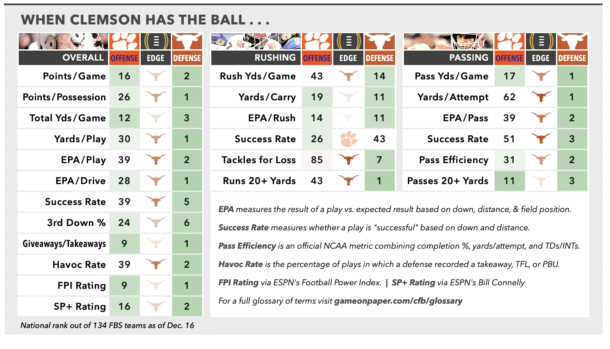
The QB: Clemson QB Cade Klubnik took a big leap forward in his second year as a starter, significantly improving on his 2023 output across the board. Nowhere was that more obvious than his success under pressure: Klubnik was PFF’s highest-graded passer nationally on pressured drop-backs, posting a stellar 80.7 overall grade under duress. (That was up from a 40.1 grade on pressured drop-backs in ’23.) For context, nearly every other Power 5 quarterback in the decade-old PFF database who posted an 80+ grade under pressure — a group that includes Kyler Murray, Joe Burrow, Caleb Williams and Jayden Daniels, among other notables — was a Heisman finalist, a Heisman winner or a future starter in the Super Bowl, or all 3.
Top Single-Season PFF Grades Under Pressure (Full-time Power 5 Starters, 2014-24)
91.5 – Bo Nix (2023 | Oregon)
90.4 – Kyler Murray (2018 | Oklahoma)*
85.9 – Joe Burrow (2019 | LSU)*
85.0 – Caleb Williams (2022 | USC)*
84.5 – Cody Kessler (2014 | USC)
84.1 – Jared Goff (2015 | California)
83.4 – Brock Purdy (2018 | Iowa State)
83.1 – Marcus Mariota (2014 | Oregon)*
82.3 – Vernon Adams Jr. (2015 | Oregon)
82.2 – Jayden Daniels (2023 | LSU)*
80.7 – Cade Klubnik (2024 | Clemson)
80.3 – Trevone Boykin (2015 | TCU)
80.2 – Trace McSorley (2018 | Penn State)
– – –
* Heisman winner
Then again, remaining above that threshold opposite Texas’ pass rush might take a Heisman-worthy performance. Long a sore point, the Longhorns’ defensive front has emerged this year as a force, reflecting both the investment the ‘Horns have made in upgrading the talent level and the development of a handful of late-blooming seniors. On the former front, 5-star underclassmen Anthony Hill Jr. and Colin Simmons are well on their way to paying off the recruiting hype, and transfer Trey Moore has been a productive (if unsung) addition from UTSA; on the latter, vets Barryn Sorrell, Alfred Collins and Vernon Broughton have all leveled up in their final year on campus. Only one player in the preceding paragraph was singled out by SEC coaches for All-SEC honors — Hill, a second-team pick at linebacker — but as a team, Texas’ 38 sacks ranked 3rd in a sack-happy league and represented the most by a UT defense since 2016.

The QBs: Not surprisingly, the season-long buzz around Texas’ quarterback situation has resulted in vastly more headlines and video tags with the words “Arch Manning” in them than meaningful reps for Manning. Not that the speculation is going to yield to reality, but with one very brief exception in a Week 8 loss to Georgia, Sarkisian has given no indication that he’s wavering on Quinn Ewers as the incumbent. In fairness to the Manning Watch, Ewers’ production since returning from a September oblique injury hasn’t exactly convinced anyone to stop looking over his shoulder, which much of the social media audience seems to do any time the offense goes more than 2 consecutive possessions without scoring. But barring a dramatic turn of events, Ewers and his 19-4 record as a starter over the past 2 seasons are not going anywhere.
If Arch does make an appearance against Clemson, it will most likely be in the red zone, where Texas ended the regular season on a low note. The Longhorns managed touchdowns on just 2-of-8 red-zone opportunities in their final 2 games, with both touchdowns coming in the regular-season finale at Texas A&M; one of those, an athletic, 15-yard run by Manning on what was supposed to be a simple 4th-and-short plunge, was an eye-opening glimpse into his potential value in something like a Baby Tebow package on short-yardage downs. His TD run against the Aggies was Manning’s 4th of the year, with 2 of the other 3 covering 67 yards (against UTSA) and 26 yards (against Mississippi State), respectively.
Even Ewers’ staunchest defenders can’t argue he brings anything like that to the table. For whatever reason, the ‘Horns didn’t go back to the well in their SEC Championship loss to Georgia, waiting until the first snap of overtime to call Manning’s number for the first and only time, for a gain of 5 yards; altogether, their 3 red-zone trips against the Dawgs (including OT) yielded just 6 points on a pair of field goals, which combined with 3 turnovers and 94 yards in penalties effectively negated a significant Texas edge in total offense. One way or another, they cannot afford to continue to leave points on the board.
Clemson’s D: This is not your older brother’s Clemson defense, especially against the run. Once a strength, the Tigers’ ranked 14th out of 17 ACC teams in rushing yards per game and per carry allowed. They came in so far below the usual curve in those categories that even excluding some egregious numbers in their 3 losses, opponents’ rushing totals in their 9 wins alone — 131.1 yards per game on 3.9 per carry — would have represented Clemson’s worst effort against the run in a decade. Explosive runs, especially, were a recurring theme: Opponents popped 26 gains of 20+ yards, most in the ACC and tied for 6th-most nationally. (By comparison, Texas’ defense allowed just 3 runs of 20+ yards, best in the nation.)
Texas is willing and able to grind it out with sophomore RB Quintrevion Wisner, who emerged from a garden-variety backfield rotation in November to establish himself as a viable workhorse. He was a clutch-time hero in closing out late wins over Kentucky and Texas A&M. But Wisner is not really a breakaway threat, and the Longhorns were vulnerable to negative plays, ranking among the bottom 10 nationally in tackles for loss allowed and havoc rate. Whatever its other problems, Clemson is still disruptive, ranking 13th in TFLs as a team and boasting 5 defenders with at least 8.0 TFLs apiece. The leader, sophomore edge TJ Parker, tied for 4th nationally with 19.5, the majority of them coming in the past 4 games. As long as they keep the lid on, the Tigers don’t have to be impenetrable. They just need to offset whatever chunks they allow by making just as many or more plays behind the line.
Bottom line: How much should we read into the fact that Texas hasn’t beaten a currently ranked opponent? It’s not the Longhorns’ fault that Michigan, Oklahoma, Florida and Texas A&M weren’t quite Top-25 material, and it’s to their credit that they handled their business in those games without an ounce of drama, which more than some other would-be contenders can say. And if we’re comparing common opponents, Texas fared a lot better in its 2 losses to Georgia — the first a competitive slugfest, the second a down-to-the-wire nail-biter — than Clemson did against the Bulldogs back in the season-opener, a 34-3 romp in Atlanta. The Tigers can argue that they’re not the same team they were nearly 4 months ago, but based on what, specifically? Their only win over a currently ranked team was the 34-31 thriller against SMU in the ACC Championship Game decided on a walk-off field goal after blowing a 17-point lead.
At any rate, assuming Texas’ defense continues to hold up its end of the bargain, the offense should have plenty of margin for error, as usual, and little incentive to open things up downfield. Longhorns fans surely would love to see Ewers (or Manning) set off some fireworks for a change, which might have to happen eventually for them to win 4 of these in a row. But there’s no reason to believe Saturday is the day.
Prediction: Texas 26 | • Clemson 17
Indiana at Notre Dame (-7)
In a season full of epic upsets, no single result makes less sense than Northern Illinois 16, Notre Dame 14 back in Week 2. Not that it made any sense at the time: The 5th-ranked Irish were the highest-ranked team in the history of the AP poll to lose a MAC opponent. But while the rest of the country took the loss as a welcome excuse to lose track of Notre Dame, the Irish took it as a wake-up call. From that point on, they blazed through the rest of the schedule like a team on a mission, winning their next 10 games by an average margin of 30.7 points. Half of those wins were decided by at least 5 touchdowns, including start-to-finish beatdowns over Army, Navy and the rotting corpse of Florida State; only one, a 31-24 decision over Louisville in Week 5, was settled by single digits.
In fact, only 1 other team nationally finished with a wider point differential this season: Indiana, which outpaced opponents by a stunning 28.6 ppg — more points than the Hoosiers had even scored per game in any of the previous 3 seasons. They didn’t trail at any point until Week 10, in an eventual 47-10 rout over Michigan State, and didn’t have a close call until the following week, in a 20-15 win over Michigan, Indiana’s first non-pandemic victory over the Wolverines since 1987.
Say what you will about their respective schedules, most of which is probably justified. (This is where I point out that Indiana’s wipeout loss at Ohio State in Week 13 was a wake-up call of a wholly different stripe than Notre Dame’s early faceplant against NIU.) But these teams are not accustomed to playing with their food. As evenly matched as they appear in the tale of the tape, given the opportunity, it’s as likely as not that one side seizes it to do what they do best: Run up the score.

IU — The Ultimate Transfer Team: Indiana is not just a transfer portal success story: It might be the transfer portal success story, with the speed and enormity of its turnaround under first-year coach Curt Cignetti eclipsing even the more high-profile portal projects at Colorado and Ole Miss. That story begins and ends, of course, with the MVP, hyper-efficient quarterback Kurtis Rourke, who vastly exceeded expectations after portaling in from Ohio U.; Rourke finished at or near the top of the FBS leaderboard in yards per attempt, overall efficiency and Total QBR en route to finishing 9th in the Heisman vote. But the overhaul remade the entire 2-deep on both sides of the ball, ultimately accounting for nearly every player who touched the ball on offense and 12 of the top 13 players in terms of snap counts on defense.
If any part of the Cignetti Plan represents a “model” for other rebuilding jobs to follow, it’s the fact that a disproportionate number of those contributors came directly from his previous stop, James Madison, where they were already established as solid starters on squad that went 11-1 in 2023. Most of JMU’s starters with remaining eligibility followed Cignetti to Indiana, and picked up more or less right where they left off. The Hoosiers’ leading receiver (Elijah Sarratt), 2nd-leading rusher (Ty Son Lawson), starting tight end (Zach Horton), leading tacklers (LBs Aiden Fisher and Jailin Walker), top edge rusher (Mikail Kamara), top interior d-lineman (James Carpenter) and top cover corner (D’Angelo Ponds) are all former Dukes. Kamara, Fisher and Ponds all earned first-team All-Big Ten nods from Big Ten coaches and media. The next school that wants to emulate the Hoosiers’ blueprint needs to think bigger than hiring a successful coach: It should hire the whole dang team.
Rourke vs. ND secondary: Notre Dame’s secondary had a dynamite year, both statistically and in terms of individual accolades for safety Xavier Watts, who repeated as a consensus All-American. Watts memorably broke out last year in a career-making performance against USC, picking off Caleb Williams twice and returning a fumble for a touchdown in a blowout Irish win; he finished with an FBS-best 7 INTs last season. He followed with 5 more this season, including a game-clinching, 100-yard pick-6 against USC in the regular-season finale. In addition to the interceptions, Watts hasn’t allowed a touchdown in coverage in either of the past 2 years, per PFF, cementing his reputation as an all-around boss on the back end.
That said, it is worth taking the Irish’s numbers against the pass with a grain of salt. For one thing, they’ve faced a mostly underwhelming slate of opposing passers, to put it mildly, including a couple of triple-option types from Navy and Army; the best QBs they faced, Louisville’s Tyler Shough and USC’s Jayden Maiava, managed to do some damage, throwing for a combined 6 touchdowns on a combined 6.9 yards per attempt. (Maiava’s 2 killer pick-6s late in the 4th quarter are hereby acknowledged.) Shough is the only opposing QB who qualified for the top 60 nationally in efficiency. For another, the Irish lost their top cover corner, aspiring first-rounder Benjamin Morrison, to a season-ending hip injury in October. His replacement, true freshman Leonard Moore, has been fine over the second half of the year. Rest assured that Sarratt and his 18.2 yards per catch will put him to the test.
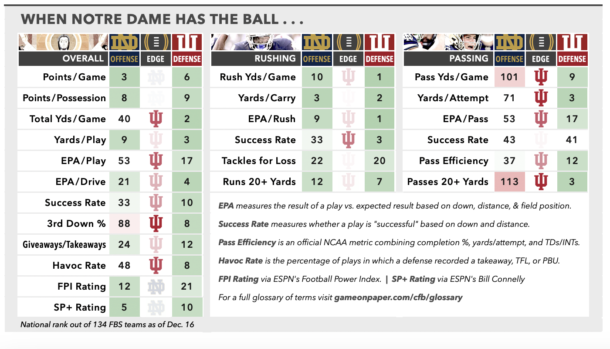
Notre Dame RBs: Can Notre Dame run the ball? So far, the answer has been a resounding yes. The Irish have not been stopped on the ground, running for 200+ yards (excluding sacks) in 9 of 12 games. They got better as the year wore on, averaging a dominant 7.1 yards per carry in November. The mainstays of the rotation, RBs Jeremiyah Love and Jadarian Price and dual-threat QB Riley Leonard, combined for 2,362 yards, 36 touchdowns and more than 100 missed tackles forced, per PFF.
Can Indiana stop the run? So far, another resounding yes. After finishing dead last in the Big Ten against the run in 2023, the rebuilt defense led the nation in ’24, holding every opposing ground game in check until the scoreboard dictated it was time to stop handing off. Nobody ran on them, including the 2 teams that were not forced to abandon the run, Michigan (69 yards on 2.0 per carry) and Ohio State (115 on 4.0 ypc). The next o-line that succeeds in pushing the Hoosiers around will be the first.
The real question is, if Notre Dame falls behind, can the Irish throw their way out of a deficit? Leonard is a perfectly competent passer with NFL potential, but he’s yet to face a situation this season where he’s left with no choice. They’d much rather go on postponing having to learn the answer to that one for as long as possible.
Bottom line: Indiana football is a complete unknown on this stage, and the lackluster schedule doesn’t help. But the Hoosiers deserve credit for running roughshod over the vast majority of that schedule without anything resembling a lapse against an inferior opponent. If they had a more familiar logo on the helmet people might be looking at them much differently, and wouldn’t be so quick to dismiss their chances to win this type of game.
While the stat sheet is a dead heat, the ostensible talent gap is difficult to overlook — Notre Dame’s roster ranks 9th in 247Sports’ Team Talent Composite. Indiana’s roster ranks 57th, for what it’s worth. That held up in the Hoosiers’ lone defeat at Ohio State, which pulled away without too much difficulty after halftime, and to a lesser extent against Michigan, the only other team to push IU for 60 minutes. Overachieving has its limits. But the fact that Indiana doesn’t have many dudes who started as 4-star recruits doesn’t mean it doesn’t have dudes. At some, point you have to leave the door open to the possibility that they’re just plain old achieving.
Prediction: • Notre Dame 32 | Indiana 21
SMU at Penn State (-9)
No program stood to benefit more from Playoff expansion than Penn State, perennial bridesmaid of the Big Ten. From 2016-23, the Nittany Lions fell in the limbo zone between No. 5 and No. 12 in the final CFP rankings 6 times — just close enough that a bid to the 4-team format remained a realistic goal, but never quite close enough that they actually threatened to make the cut in the end. Depending on which faction of the fan base you asked, patience with James Franklin and his dismal record against Playoff-caliber competition tended to be just as vague.
All of which is to say that, however relieved they are to finally call themselves a Playoff team, they’re not just happy to be here. True, the ’24 Lions have yet to move the needle against the upper crust, dropping their only 2 opportunities so far against Ohio State and Oregon by a combined 15 points. For once, though, neither loss felt like a deal-breaker: They were on the doorstep of an upset against the Buckeyes, and the committee declined to hold a competitive, 60-minute effort against the Ducks in the Big Ten Championship Game against them. They’re solid favorites to advance to the quarterfinals, and almost certainly will be again in a Fiesta Bowl date with Boise State if they do.
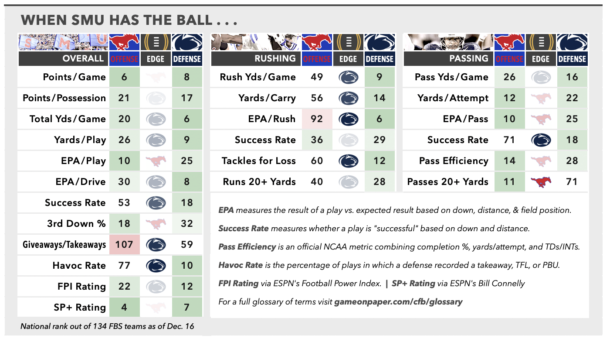
QB Kevin Jennings is different … in every way: Like Indiana, SMU’s roster came overwhelmingly out of the portal: Every single player who’ll touch the ball, the entire starting offensive line, and all but a smattering of the 2-deep on defense began their career at another FBS school. The exception is the starting quarterback, Kevin Jennings, a local recruit who nobody prior to the season would have predicted would be the guy to lead the Mustangs to this stage. That was supposed to a different local recruit, incumbent starter Preston Stone, who seemed well on his way to living up to his blue-chip recruiting hype after leading SMU to an 11-3 record and an American Athletic Conference Championship in 2023. But Stone got off to a slow start, Jennings gave the offense a jolt off the bench, and the rest is history. (Stone will remain with the team as a backup through the Playoff, although he’s barely seen the field since September and plans to transfer after the season.)
Jennings wears the “dual threat” label at 6-0, 189 pounds, but while nobody’s about to mistake him for a towering pocket slinger like his Penn State counterpart, Drew Allar, he was more productive passing than running. He ranked 2nd in the ACC (behind only Miami’s Cam Ward, a Heisman finalist) in yards per attempt and efficiency, and 3rd in completion percentage.
In conference play, he threw for 250+ yards in all but 1 game and connected on multiple TD passes in all but 2. And he arguably saved the Mustangs’ Playoff bacon in the ACC Championship Game, leading 3 4th-quarter scoring drives to erase a 17-point gap against Clemson. Despite their eventual loss on a walk-off field goal, the late rally made it much easier for the CFP committee to stick with SMU in the final at-large slot despite a late, loud push for Alabama. If you were dreading the prospect of Bama being ushered behind the rope just 2 weeks removed from their Week 13 meltdown at Oklahoma, you have Jennings to thank for leaving the committee with little choice but to preserve its dignity.
Contain Abdul Carter: The best player on the field on Saturday, like every Saturday this season, will be Penn State edge rusher Abdul Carter, a converted linebacker who made such a seamless transition to the edge as a junior it’s a wonder it took 3 years to make it happen. Before the season, Carter drew inevitable comparisons to Micah Parsons for obvious if shallow reasons: They’re about the same size, they wear the same jersey number (11), and Parsons himself famously made the move from linebacker to the edge in the NFL. But lo and behold, the comp held up. Freed from responsibilities in coverage, Carter was a week-in, week-out presence in opposing backfields, finishing at or near the top of the Big Ten in QB pressures, sacks and TFLs on his way to being named a unanimous All-American. The first round beckons, very possibly as the No. 1 edge rusher off the board.
SMU’s starting tackles, PJ Williams and Savion Byrd are not chopped liver: They’re both former top-100 overall recruits who portaled in from Texas A&M and Oklahoma, respectively, and have started every game. They did struggle a bit against Clemson, allowing a combined 8 QB pressures and a strip sack on the opening series that turned the momentum against the Mustangs right out of the gate. But frankly, there isn’t a tackle in the college game who can be trusted to hold up on an island against Carter. SMU must have a plan to help the tackles, get the ball out of Jennings’ ASAP, or preferably both.

Tyler Warren is him: One of the looming question marks before the season was the absence of anyone resembling a go-to wideout, and one of the major developments has been the emergence of tight end Tyler Warren in that role. Warren wears many hats in the offense, including short-yardage/Wildcat quarterback. Strictly as a receiver, though, he has proven indispensable as Allar’s favorite target, finishing 2nd among all Big Ten receivers in receptions (88) and yards (1,062) and No. 1 in catches of 15+ yards (30). PFF credited him with 11 contested catches on 15 attempts vs. just 2 drops on 112 total targets; Heisman voters made him the first true tight end to finish in the top 10 in the final vote since Notre Dame’s Ken MacAfee in 1977.
Having closely covered Brock Bowers’ career at Georgia, I’m not prepared to anoint Warren as the best college tight end of the past 45 years. But he is certainly up there, and his presence frees up the actual wideouts (namely Harrison Wallace III) to stretch the field rather than allowing defenders to plant their feet at the sticks. SMU safety Isaiah Nwokobia, a first-team All-ACC pick, stands to make himself quite a bit of money if he can hold his own in the role of Warren’s shadow.
Bottom line: If you’re reluctant to consider Penn State as one of the teams with the juice to win it all, well, that’s understandable. The Lions haven’t been real contenders in a long time and haven’t beaten a real contender in almost as long. As for this team, specifically, the offense didn’t inspire much confidence in the loss to Ohio State, and the defense didn’t inspire much confidence in the loss to Oregon. When Allan and Warren are in sync, though, the pieces are all there, and it’s not hard to imagine them falling into place in time to make a serious run. All we need to see is proof of concept in a game with actual stakes.
Prediction: Penn State 31 | • SMU 21
Matt Hinton, author of 'Monday Down South' and our resident QB guru, has previously written for Dr. Saturday, CBS and Grantland.
